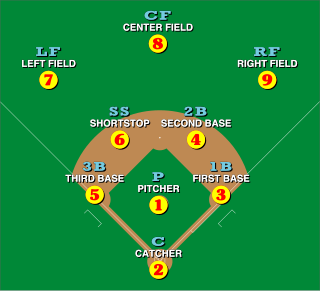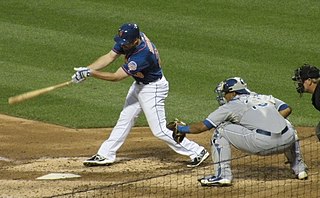Related Research Articles

In the sport of baseball, each of the nine players on a team is assigned a particular fielding position when it is their turn to play defense. Each position conventionally has an associated number, for use in scorekeeping by the official scorer: 1 (pitcher), 2 (catcher), 3, 4, 5, 6 (shortstop), 7, 8, and 9. Collectively, these positions are usually grouped into three groups: the outfield, the infield, and the battery. Traditionally, players within each group will often be more able to exchange positions easily ; however, the pitcher and catcher are highly specialized positions and rarely will play at other positions.

Softball is a sport similar to baseball, and it is played with a larger ball on a smaller field and with only underhand pitches permitted. Softball is played competitively at club levels, the college level, and the professional level. The game was first created in 1887 in Chicago by George Hancock.

The Catcher in the Rye is a novel by American author J. D. Salinger that was partially published in serial form in 1945–46 before being novelized in 1951. Originally intended for adults, it is often read by adolescents for its themes of angst and alienation, and as a critique of superficiality in society. The novel also deals with themes of innocence, identity, belonging, loss, connection, sex, and depression. The main character, Holden Caulfield, has become an icon for teenage rebellion. Caulfield, nearly of age, gives his opinion on a wide variety of topics as he narrates his recent life events.

Dodgeball is a team sport in which players on two opposing teams try to throw balls and hit opponents while avoiding being hit themselves. The objective of each team is to eliminate all members of the opposing team by hitting them with thrown balls, catching a ball thrown by an opponent, or inducing an opponent to commit a violation, such as stepping outside the court.

In baseball, the pitcher is the player who throws ("pitches") the baseball from the pitcher's mound toward the catcher to begin each play, with the goal of retiring a batter, who attempts to either make contact with the pitched ball or draw a walk. In the numbering system used to record defensive plays, the pitcher is assigned the number 1. The pitcher is often considered the most important player on the defensive side of the game, and as such is situated at the right end of the defensive spectrum. There are many different types of pitchers, such as the starting pitcher, relief pitcher, middle reliever, lefty specialist, setup man, and the closer.

Crowd surfing is the process in which a person is passed overhead from person to person, transferring the person from one part of the venue to another. The "crowd surfer" is passed above everyone's heads, with everyone's hands supporting the person's weight. At most concerts and festivals the crowd surfer will be passed towards a barrier in front of the stage by the crowd, where they will be pulled off and put on their feet by the security stewards. Then, they will be sent back to the side or rear of the crowd at the end of the barrier or they may be ejected from the venue. Other venues may allow the crowd surfer to go onto the stage with the artist for a brief period of time before stage diving or being escorted off the stage.

Catcher is a position in baseball and softball. When a batter takes their turn to hit, the catcher crouches behind home plate, in front of the (home) umpire, and receives the ball from the pitcher. In addition to this primary duty, the catcher is also called upon to master many other skills in order to field the position well. The role of the catcher is similar to that of the wicket-keeper in cricket.

Tag is a playground game involving one or more players chasing other players in an attempt to "tag" and mark them out of play, typically by touching with a hand. There are many variations; most forms have no teams, scores, or equipment. Usually when a person is tagged, the tagger says, "It!" or "Tag, you're 'It'!" The last one tagged during tag is "It" for the next round. The game is known by other names in various parts of the world, including "running and catching" in India and "catch and cook" in the Middle East.

A trampoline is a device consisting of a piece of taut, strong fabric stretched between a steel frame often using many coiled springs. People bounce on trampolines for recreational and competitive purposes.

A squat is a strength exercise in which the trainee lowers their hips from a standing position and then stands back up. During the descent, the hip and knee joints flex while the ankle joint dorsiflexes; conversely the hip and knee joints extend and the ankle joint plantarflexes when standing up. Squats also help the hip muscles.
An icebreaker is a brief facilitation exercise intended to help members of a group begin the process of working together or forming themselves into a team. Icebreakers are commonly presented as a game to "warm up" the group by helping the members to get to know each other. They often focus on sharing personal information such as names, hobbies, etc. Ice-breakers are also used at social gatherings such as parties in order to introduce guests to one another in situations where they may not know one another.

British Bulldog is a tag-based playground and sporting game, commonly played in schoolyards and on athletic fields in the UK, Canada, South Africa, Australia, and related Commonwealth countries, as well as in the U.S. and Ireland. The object of the game is for one player to attempt to intercept other players who are obliged to run from one designated area to another. British Bulldog is characterised by its physicality and is often regarded as violent, leading it to be banned from many schools due to injuries to the participants.

Charles Louis "Chief" Zimmer was an American professional baseball player whose playing career spanned from 1884 to 1906. He played for 19 seasons as a catcher in Major League Baseball (MLB), including 13 seasons for the Cleveland Blues/Spiders (1887–1899), three seasons for the Pittsburgh Pirates (1900–1902), and one season as the player/manager of the Philadelphia Phillies (1903).

Buck buck is a children's game with several variants. One version of the game is played when "one player climbs another's back" and the climber guesses "the number of certain objects out of sight". Another version of the game is played with "one group of players [climbing] on the backs of a second group in order to build as large a pile as possible or to cause the supporting players to collapse."

Tree pose or Vrikshasana is a balancing asana. It is one of the very few standing poses in medieval hatha yoga, and remains popular in modern yoga as exercise. The pose has been called iconic of modern yoga; it is often featured in yoga magazines, and practised in public displays such as for the International Day of Yoga.
Traditional Filipino games or indigenous games in the Philippines are games that are played across multiple generations, usually using native materials or instruments. In the Philippines, due to limited resources for toys, children usually invent games that do not require anything but players. There are different kinds of Filipino traditional games which are well-suited for kids, and the games also stand as one of the different cultural and traditional games of the Philippines. Due to the variety of skills used in these games, they serve an important purpose in the physical and mental development of Filipino children. These games are also an important part of Filipino culture.

Balance in biomechanics, is an ability to maintain the line of gravity of a body within the base of support with minimal postural sway. Sway is the horizontal movement of the centre of gravity even when a person is standing still. A certain amount of sway is essential and inevitable due to small perturbations within the body or from external triggers. An increase in sway is not necessarily an indicator of dysfunctional balance so much as it is an indicator of decreased sensorimotor control.

Falling is the action of a person or animal losing stability and ending up in a lower position, often on the ground. It is the second-leading cause of accidental death worldwide and a major cause of personal injury, especially for the elderly. Falls in older adults are a major class of preventable injuries. Construction workers, electricians, miners, and painters are occupations with high rates of fall injuries.

A playground, playpark, or play area is a place designed to provide an environment for children that facilitates play, typically outdoors. While a playground is usually designed for children, some are designed for other age groups, or people with disabilities. A playground might exclude children below a certain age.
References
- ↑ "Trust Building Activities". Venture Team Building. 28 April 2013. Retrieved 26 October 2021.
- ↑ "The Trust Fall Team Building Activity". The Trust Fall Team Building Activity. 18 January 2011. Retrieved 30 May 2019.
- ↑ "Australian Diplomat Killed During LES Trust Fall, Sources Say". Madison, NJ Patch. 15 November 2017. Retrieved 23 September 2022.
- ↑ "Student Says Leadership Class Ruined Him". www.courthousenews.com. Retrieved 23 September 2022.
- ↑ "TRUST ME". Tribune Content Agency. 7 September 2016. Retrieved 30 May 2019.